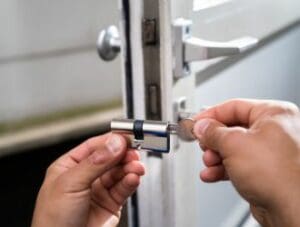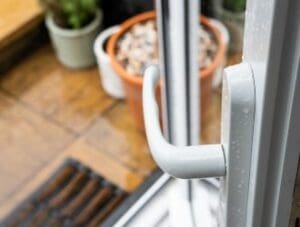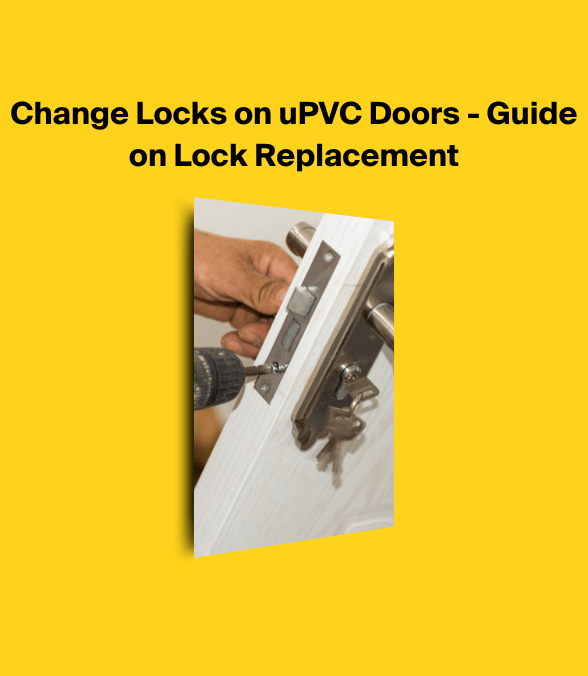Change Lock uPVC Door

Is the lock on your uPVC doors giving you some trouble?
Well, as annoying as it may be, it might be time to remove and replace your uPVC lock.

Build your door today!
Get a Quote
Look no further if you’re wondering how to change the lock on a uPVC door.
Our guide demystifies the process, offering clear, actionable instructions—ensuring you can confidently enhance your home’s security.
Replacing Lock in uPVC Doors - Summary
- Replacing UPVC door locks is essential for maintaining home security, especially after wear or if there’s a risk of unauthorised key duplication. It involves selecting the right lock type and ensuring it’s compatible with the door and keys.
- Indications that a UPVC door lock needs replacement include difficulty in key insertion, handle resistance, visible damage, and irregular latch function. Regular replacement, approximately every 7 years, is suggested to uphold security standards.
- Proper tools such as screwdrivers, Allen keys, and a new lock cylinder are required for lock replacement. While the task is DIY-possible, hiring a professional locksmith can provide a secure and precise installation, which is beneficial in complex situations.
UPVC Door Lock Basics
Before you get ahead, let's review some of the basics regarding uPVC locks and their features.
A UPVC door lock is an integral part of any home security system. It is designed to safeguard your home and prevent unauthorised access.
One of its components is the lock barrel screw, which secures the lock in place. But, like any other device, it can wear out over time or become compromised. So, what do you do when this happens?
Indeed, changing a UPVC door lock is not only feasible but also a significant measure to boost your home’s security. This procedure involves removing and replacing the old lock with a new one.
The significance of changing a lock on a UPVC door lies in its ability to maintain the security of your home.
Particularly in cases where the previous lock is compromised or there is a potential threat of unauthorised key duplication.
If you ever need to change a uPVC door, it’s essential to ensure the lock is replaced to maintain optimal security.
Types of UPVC Door Locks
UPVC door locks come in various types, each designed to offer high security.
You might have encountered terms such as barrel locks, cylinder locks, and those with circular keyways. But what do they mean, and what are their features?
For instance, a Euro cylinder lock, with its intricate internal design, deters break-ins and enhances your home’s security.
When you replace a UPVC door lock, ensure you have new door keys that are compatible with the new lock. Brands like:
- Avocet
- Fullex GU
- Ferco
- Mila
- Roto
- Yale
UPVC doors are known for their high-quality UPVC door locks.
Selecting the Right UPVC Door Lock
Given the many UPVC door lock choices, selecting the right one for your home can be challenging. Choosing a UPVC door lock should be based on your unique requirements and needs.
One key aspect is ascertaining the correct size of the euro-cylinder locks for your UPVC door.
A locksmith can help you determine this by extracting the lock and measuring the distance from the end of the cylinder barrel to the centre of the black line on each side.
When to Replace Your UPVC Door Lock
Recognising the right time to replace your UPVC door lock is equally important as understanding the replacement process. But what are the signs that indicate it’s time for a change?

You may need to consider a replacement if you face challenges inserting the key into the lock if the door handles resist you, or if you have difficulty turning them.
Other signs include visible damage to the lock, a loose handle, and sporadic functionality of the door latch.
You can attempt to fix a loose door handle if this is the problem, as this can be done with the help of a few tools.
It’s also advisable to replace the lock if the barrel screw is damaged or if the lock has been in use for an extended period and starts to exhibit signs of failure.
While UPVC door locks don’t need regular replacement solely for security, you might want to consider replacing them every 7 years to address wear and tear and ensure compliance with current security standards.
Tools Needed for Changing a UPVC Door Lock
Replacing a UPVC door lock requires not only a new lock but also the appropriate tools, much like any uPVC door repair. Utilising the correct tools is vital for a successful and secure replacement of a UPVC door lock.
This minimises the risk of damage to the door or the lock mechanism and ensures efficient task completion. Some essential tools for replacing a UPVC door lock include:
- Screwdriver
- Allen key
- Pliers
- Hammer
- Chisel
- Drill
- Tape measure
These tools will make the process much easier and ensure you can complete the replacement without any issues.
So, what do you need? A basic tool kit for replacing a UPVC door lock includes:
- Phillips-head screwdriver: vital for unfastening screws that secure the UPVC door handles and lock, thus playing a key role in the lock replacement process
- Compatible lock cylinder
- Pencil and paper
- New lock if needed
You’ll also need a new UPVC door lock, screwdriver, and lock cylinder.
Step-by-Step Process for Changing a UPVC Door Lock
So, now that you have all the tools you need, you are ready to replace your door lock.
Changing a UPVC door lock might seem daunting if you’re doing it for the first time. However, it can be a manageable task with the right tools and instructions.
We will go through each step of the process here so that you can change a uPVC door lock whenever you need to.
Removing the Old Lock
The first step in the lock replacement process is removing the old lock from your door. But how exactly do you go about this?
To begin, remove the screw located under the door lock on the edge of the door. This will allow you to disassemble the locking mechanism.
Then, slightly turn the key and pull the barrel lockout with a gentle tug while the key is in the unlock position.
After removing the lock faceplate and the door handle, gently extract the old lock mechanism without damaging the door or frame.
During the process, remove the door handle by loosening the screws holding it in place with a Phillips-head screwdriver, and slide the interior and outer handle apart.
Follow this by removing the barrel screw located on the side of the UPVC door. After these steps, the barrel lock can be extracted by eliminating the ball bearings on both sides.
Installing the New Lock Barrel
Once the old lock is out, the next step is to install the new one.
But before you do that, it’s crucial to gather key measurements such as the overall length of the door, the backset, and the distance from the handle to the cylinder.
These measurements ensure the new lock cylinder properly fits in the door and functions optimally without compromising security.
To install the new lock, follow these steps:
Step 1: Align Lock Barrel
Align the new lock barrel with the door and insert it into the designated slot, ensuring proper alignment with the door frame and a flush fit.
Step 2: Secure the Handle
Next, you will want to ensure you have a door handle fitted. To do this, secure the handle in the spindle hole. Do this for both sides to ensure you can open and close the door from either side.
Step 3: Test the Barrel Lock
Test the barrel by twisting the key to ensure smooth insertion and normal key operation.
Step 4: Tighten Lock Barrel Screw
Insert and tighten the screws at the top and bottom of the handle, but don't screw them too tightly. Once this is done, the process should be completed, and your uPVC door handle will have been replaced.
Note that the key is essential to replacing the lock barrel. In the absence of a key, a locksmith or a door lock specialist is required.
Enhancing UPVC Door Security
Everyone wants to feel secure in their home, and having high security is important.

While changing your UPVC door lock is an essential step toward home security, you can do more to enhance the protection.
There's also the argument of composite doors vs uPVC doors regarding which material is better and which is superior in terms of security.
Choosing High-Quality Locks
Adopting high-quality locks, like anti-snap locks, is a fundamental step in enhancing your UPVC door’s security.
These locks enhance UPVC door security by mitigating lock snapping and providing superior security compared to standard locks.
Brands like Avocet or Yale are known for superior quality and security features.
Adding Additional Security Measures
Beyond selecting high-quality locks, there are additional measures you can take to enhance your UPVC door security further. These may include:
- Installation of sash jammers
- Door chains
- Hinge bolts (uPVC door hinge adjustments may be required)
- Anti-snap locks
- Add door/window security sensors
For instance, a UPVC door security chain provides an additional layer of security. It allows the door to be partially opened while maintaining security against unauthorised entry.
Other measures, like installing a peephole, can also provide additional security.
You could also consider integrating a supplementary bolt or chain into your UPVC door for additional protection.
DIY vs. Hiring a Professional Locksmith
Now that you’ve learned the basics of changing a UPVC door lock, should you do it yourself or hire a professional locksmith?
Although replacing a UPVC door lock yourself is doable, situations may arise when engaging a professional locksmith could prove advantageous.
For instance, if you’re unsure about the replacement procedure or don’t have the key to change the lock barrel, you might want to consider enlisting a professional’s help.
A professional locksmith has extensive experience and uses advanced tools, guaranteeing the secure and accurate installation of the lock. While the initial cost may seem higher, it can prove more cost-effective in the long run.
Troubleshooting Common UPVC Door Lock Issues
UPVC door locks can sometimes present issues even after proper installation and maintenance. Troubleshooting these common problems can save you time and unnecessary stress.
Typical issues with UPVC door locks encompass lock snapping, misaligning locks, and sticking door locking mechanisms.
If your UPVC door lock mechanism is sticking or stiff, try applying a silicone-based lubricant into the keyway and inserting and removing the key several times to assess any improvement.
If the problem persists, it may be advisable to seek the expertise of a professional locksmith.
Maintaining Your UPVC Door Lock
Adequate maintenance of your UPVC door lock guarantees its durability and peak performance. So, how can you maintain your UPVC door lock?
Regular cleaning and lubrication are the cornerstones of UPVC door lock maintenance. To ensure optimal performance, it’s recommended that they be cleaned and lubricated at least twice a year.
A smooth operation can be ensured by regularly cleaning the lock mechanism using a damp cloth and lubrication every six months with a dust-resistant product such as graphite-based oil.
It is recommended that UPVC solvent cream cleaners specifically designed for UPVC frames and doors be used for cleaning.
Dry lubricants such as graphite powder and PTFE lubricants are preferable for lubrication, as oil-based products may attract dust and dirt.
Changing uPVC Locks - Final Thoughts
Now that you've gone through our step-by-step guide, you should hopefully know more about uPVC lock replacement and increasing security on your property.
Maintaining your home's security doesn’t have to be daunting. With the right knowledge and tools, you can replace your UPVC door lock, enhance your door security, and troubleshoot common issues.
The key is knowing when to tackle it yourself and when to call in the professionals to ensure the protection and safety of your own house.
Frequently Asked Questions
Can you change a uPVC door lock yourself?
Yes, you can change a uPVC door lock yourself with a simple tool kit and some patience, saving money and gaining new skills.
Can you replace the locking mechanism on a uPVC door?
You can replace the locking mechanism on a uPVC door by selecting the correct size central gearbox and using a screwdriver or drill to change it over.

It is important to ensure you have the same type of lock mechanism when replacing it.
What signs show that it is time to replace my UPVC door lock?
What tools do I need to replace a UPVC door lock?
To replace a UPVC door lock, you will need a Phillips-head screwdriver, a compatible lock cylinder, pencil and paper, and a new lock if necessary. These tools will help you complete the task effectively.
How can I enhance the security of my UPVC door?
You can enhance the security of your UPVC door by installing additional measures such as sash jammers, door chains, hinge bolts, and anti-snap locks, in addition to using high-quality locks.
This will provide added protection for your door.









